 Leading Blog | Posts by Month |
 Leading Blog | Posts by Month |
12.31.09

LeadershipNow 140: December 2009 Compilation
Posted by Michael McKinney at 07:43 AM
12.30.09

Is Business Just About Making Money?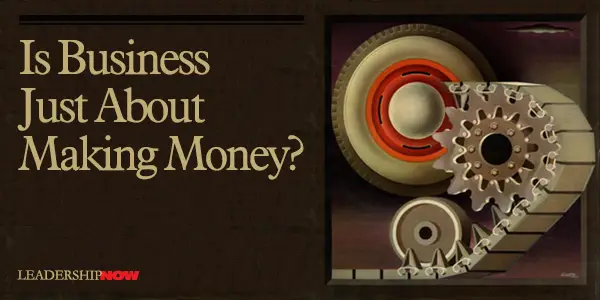
WE’VE all heard, “The business of business is making money. If you don't make money, you won't stay in business for long. If you don't have it you can't give it.” The question for business is: “Can you ever care about anything other than profits?” How to be profitable and socially responsible is not always self-evident. Daylian Cain, a professor at Yale School of Management who specializes in conflict of interest issues says that “acting on your values in the workplace can be more complex than it seems.” 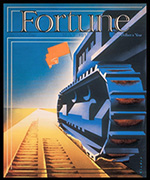 Realities of the marketplace often clash with social responsibility. It costs money to do more than look after the bottom line—to do the right thing for employees, the local community and society at large. As consumers, we demand lower prices. We don’t want to pay any more than we have to. If we can buy a product for half the price of a similar product, we usually do. But what if that behavior drives the socially responsible business out of the marketplace? Just because we can squeeze out another dollar, should we? By acting in our own "best interest" are we bankrupting socially responsible efforts? Are we willing to pay the price for social responsibility?
Professor Ray Fisman of Columbia Business School remarked, "There is no shortage of inspiring examples of companies who have made money and done good for the world, but I wouldn't want to frame it as a generalized principle. There are also companies that have made enormous sums of money by not doing good. I think suggesting that good citizenship is always a win-win can be dangerously misleading." Most businesses and consumers want to do the right thing. But our commitment is really put to the test when it costs us something. Principles consistently applied over time are the ones we really care about. Cain said “A lot of students have mixed feelings about the purpose of business. [They wonder if it’s] really only to make a profit. One of my jobs is to provide a safe space for sharing those views. One of the challenges is not merely to educate about these problems but to try to change behavior.” Social responsibility, he says, “is about doing good because it’s the right thing.” Social responsibility is more complex than just pointing a finger and saying, “Clean it up.” Although we don’t like it anymore, we have what we wanted. The question is: are we willing to pay the price—in terms of money, time, attitudes, habits, and beliefs—to get the kind of world we now seek?
Posted by Michael McKinney at 12:36 AM
12.28.09

Avoiding the Unforced ErrorWe all make them. Ethics breaches, sex scandals and performance-related turnover are increasingly found in today’s headlines. As in tennis, the unforced error is made by someone with the ability to keep the ball in play but who makes a mistake, resulting in the loss of a point. To improve your game you need to develop the habits that will help you keep the ball in play. It is your performance over time—a steady game—that will get you where you want to go. That’s what The Unforced Error by Jeffrey Krames aims to help you do.The most dangerous errors—and the one discussed in this book—are “the ones we don’t recognize, so we can’t fix them before the damage is done.” Krames divides unforced errors into two groups: the unforced operating error (the ones we all make in the course of doing our job; a bad call) and the unforced nonoperating error (errors not directly related to the conducting of business, but can shatter a career nonetheless; sexual affairs and errors of character). Krames writes, “There are seldom excuses for unforced nonoperating errors. You have to have the awareness, self-control, and maturity to avoid them.” The focus of this book is the former kind, the unforced operating error. There is a key to avoiding unforced errors. Not surprisingly, the key is humility. “That’s because humility—one of the most underrated of all leadership qualities—is essential to developing the strength and consistency to avoid unforced errors.” It’s the kind of humility that comes from having the self-confidence to admit mistakes, blind spots and then move on to correct the mistake. Rarely would you be told that you were fired due to a lack of humility, but it is the trigger for so many unforced errors. Krames successfully helps you to recognize an unforced error when you see it. In each chapter that covers a specific unforced error, he offers sensible and pragmatic advice on how to avoid these “career killers.” His advice includes:
Of related Interest:
Posted by Michael McKinney at 08:13 AM
12.25.09

Best Leadership Books of 2009
As we reflect on the year 2009 – the financial crisis and the accompanying recession – we know that out of the chaos, we must relearn some basics and not return to business as usual. Shortcuts are out. The Harvard Center for Public Leadership's 2009 National Leadership Index reveals that 69% of Americans think we have a leadership crisis in the country. Another 67% believe that "unless we get better leaders, the United States will decline as a nation." Over half (52%), believe that business leaders generally work to benefit themselves. Only 25% of Americans agree or strongly agree that business leaders or news media leaders share their values. And this isn’t just an American phenomenon. As Pogo Possum observed, “We have met the enemy and he is us.” The tendency is to catch our breath and just work harder. But we have to hit reset and work differently—to incorporate the larger picture; to not be so insular in our behavior. The Financial Times management columnist Stefan Stern remarked, “The reason why so many people want to get back to ‘business as usual’ is that that is what they do best. In fact, it may be all that they can do.” Overcoming inertia is going to be the challenge. Back to basics. This doesn’t mean safe and boring or watered-down. These are bedrock principles that work. It’s when we try to take shortcuts that we get derailed. Consultant icon Tom Peters who has a reputation for being cutting-edge, has been relentlessly preaching the simple basics that work. And work globally. Basics are the new cutting-edge. The present environment reminds us that leadership must exist at all levels. Everyone has a part to play. Sound principles take you through good times and bad. Business (and individuals) will have to focus more on training both on the job and off so that sound values and principles become everyday practice. The books selected for the best leadership books published in 2009 help us to think differently; to incorporate lasting values; to answer the question, “How do we best lead?” The biographies selected here more than just life stories; they are great histories as well. Vanderbilt was a man of enormous accomplishments. At the time of his death he owned five percent of America's wealth. And while there are lessons to be learned from the life of Vanderbilt, he is in many respects, not a model to follow. Still, The First Tycoon is a page-turner that captures well the people he worked with and the culture he operated within, making it a worthwhile history of the rise of American corporate capitalism. Cooper’s biography of one of the nation's most controversial leaders, Woodrow Wilson, is an authoritative, in-depth look at a complicated and fascinating man. It also serves as a great political history that is still relevant today. The bicentennial year of Lincoln’s birth saw the release of many books about the 16th president. A. Lincoln is an engaging narrative and one of the best. Lincoln, says White, continues to fascinate us "because he eludes simple definitions and final judgments."
Posted by Michael McKinney at 12:01 AM
12.23.09

The Nature of Small Wins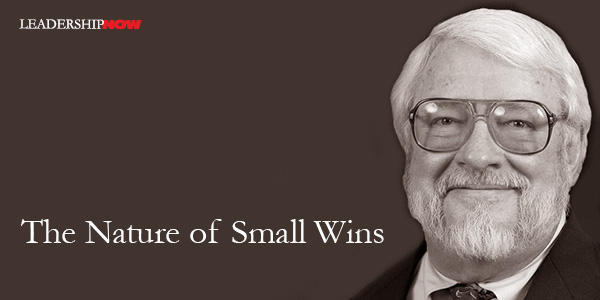
IN the face of overwhelming problems, we can feel helpless to do anything. Organizational theorist Karl Weick argues that calling a situation a serious problem requiring a sweeping change may be when the real problem starts. (e.g., "I can't solve that problem, so I'll just focus on something else.") And so nothing gets done. In the article Small Wins: Redefining the Scale of Social Problems, Weick explains that small wins help to create an environment where change is not overwhelming and therefore more likely to happen. He writes, "The massive scale on which social problems are conceived often precludes innovative action because the limits of bounded rationality are exceeded...People often define social problems in ways that overwhelm their ability to do anything about them." In order to solve social problems, he suggests that we define them as a series of smaller problems that can then be affected by small wins. He defines small wins as a "series of concrete, complete outcomes of moderate importance [that] build a pattern that attracts allies and deters opponents." This strategy of focusing on “a series of controllable opportunities of modest size that produce visible results”, works directly on the construction of a problem and indirectly on its resolution. A small win is a concrete, complete, implemented outcome of moderate importance. By itself, one small win may seem unimportant. A series of wins at small but significant tasks, however, reveals a pattern that may attract allies, deter opponents, and lower resistance to subsequent proposals. While small wins provide less effort to produce and provide stable building blocks to build on, they are not orderly because each small win changes the context for the next small win. Weick explains: “Small wins have a fragmentary character driven by opportunism and dynamically changing situations. Small wins stir up settings, which means that each subsequent attempt at another win occurs in a different context. Careful plotting of a series of wins to achieve a major change is impossible because conditions do not remain constant. Much of the artfulness in working with small wins lies in identifying, gathering, and labeling several small changes that are present but unnoticed, changes that in actuality, could be gathered under a variety of labels.
Posted by Michael McKinney at 07:57 AM
12.21.09

Warren Buffett on Business
RICHARD CONNERS has done us a service by creating a collection of Warren Buffett’s writing and thoughts over the last 40 years. Warren Buffett on Business is a selection Berkshire Hathaway letters written over the last 40 years and the occasional Buffett interview or comment. Conners has categorized these into 18 topics like corporate culture, executive compensation, executive behavior, risk management, mistakes I’ve made, and humor and stories. Conners, who teaches a course on Warren Buffett at Washington University in St. Louis says Buffett’s “genius is in his character. His integrity is unsurpassed. His patience, discipline, and rationality are extraordinary.” Here are a few business principles in Buffett’s own words: It takes 20 years to build a reputation and five minutes to ruin it. If you think about that, you’ll do things differently. I think we have a very good culture virtually everyplace in Berkshire. I hope it’s everyplace. This is what we are looking for, and it’s more a question of culture than controls. If you have a good culture, I think you can make the rules pretty simple. An observer might conclude from our hiring practices that Charlie and I were traumatized early in life by an EEOC bulletin on age discrimination. The real explanation, however, is self-interest: It’s difficult to teach a new dog old tricks. The many Berkshire managers who are past 70 hit home runs today at the same pace that long ago gave them reputations as young slugging sensations. Therefore, to get a job with us, just employ the tactic of the 76-year-old who persuaded a dazzling beauty of 25 to marry him. “How did you ever get her to accept?” asked his envious contemporaries. The comeback: “I told her I was 86.” We cherish cost-consciousness at Berkshire. Our model is the widow who went to the local newspaper to place an obituary notice. Told there was a 25-cent-a-word charge, she requested “Fred Brown died.” She was then informed there was a seven-word minimum. “Okay” the bereaved woman replied, “make it ‘Fred Brown died, golf clubs for sale.’” I’ve said many times that when a management with a reputation for brilliance tackles a business with a reputation for bad economics, it is the reputation of the business that remains intact. I just wish I hadn’t been so energetic in creating examples. My behavior has matched that admitted by Mae West: “I was Snow White, but I drifted.” My most surprising discovery: the overwhelming importance in business of an unforeseen force that we might call “the institutional imperative.”… I thought…that decent, intelligent, and experienced managers would automatically make rational business decisions. But I learned over time that isn’t so….For example:
Institutional dynamics, not venality or stupidity, set businesses on these courses, which are too often misguided. It’s no sin to miss a great opportunity outside one’s area of competence. I tell students to do work for an organization you admire or an individual you admire, which usually means that most MBAs I meet become self-employed. 
Posted by Michael McKinney at 07:36 AM
12.18.09

We Hire For Difference and Fire Because They Are Not the SameBringing true diversity to the workplace is a lot harder than we thought. It is more than just playing Noah and getting the numbers right—two of every kind. But, too often that’s as far as it goes. What is needed, says Laura Liswood in The Loudest Duck, is “more sophisticated leadership, conscious awareness, thought, behavior, and tools to reap the benefits of what true diversity can provide.”Diversity has to be something deeper. True diversity requires a change in attitude and thinking. It requires a change in the way we think about people that are different—age, gender, race, accent, appearance, background, personality, religion or education—than we are. We all have unconscious reactions to people that are different. Liswood writes, “We are not talking about blatant inequities or discrimination in most of today’s professional world (although this still does occur). We are talking about unconscious belief, preferences, values, thoughts, and actions. These are what erode the promise of diversity.” To achieve true diversity, we need to examine what we believe; beliefs that we begin to develop at a very early age and continue to learn and reinforce throughout our lives. “Getting true value out of diversity is much harder than was initially thought….Managing diversity requires heightened emotional intelligence, awareness, observation, and listening skills.” At the same time, Liswood argues, “employees have to take it upon themselves to get out of their comfort zones and learn to adjust to a company’s style, but not in a manner that merely shows compliance.” In today’s environment, whether the loudest duck gets heard or whether it gets its head chopped off, is not only a management issue, but additionally a large part of the responsibility lies with every individual to develop awareness and an understanding of what works and when in their particular situation. Throughout the book she offers tools and approaches to help you stretch yourself in the workplace. The phrase “We hire for difference and fire because they are not the same,” sums up the dynamic very well. The Loudest Duck provides a framework to begin to do the inner work necessary to bring about true diversity. The thing is, if you are not consciously inclusive of everyone, you will unconsciously narrow the type of players in your organization and never reap the benefits of true diversity. Accepting every kind of person is much harder than it sounds because we judge people differently based on our own internal filtering system that tells us what to value and what to ignore or tolerate. That’s where diversity needs to take hold if it is ever going to take hold in our organizations or in our communities.
Posted by Michael McKinney at 12:31 AM
12.17.09

Teaching, Like Leadership, is a Labor of Love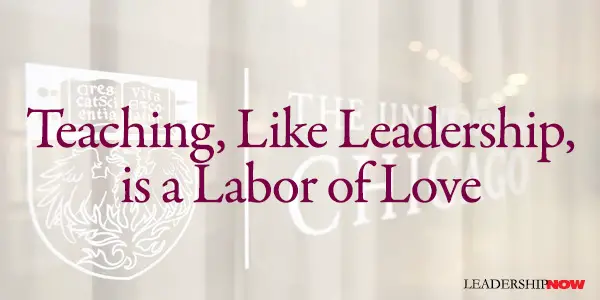
MUCH of what we do everyday involves some kind of teaching—conveying information to others. We can be enlightened by the discussions from the educational arena on what it means to teach and how people learn. Teaching done right is really a labor of love. It’s having a mind oriented toward the future; seeing a bigger picture beyond what is actually being taught in the present. 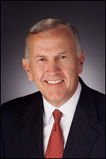 Magill says that the faculty at the Laboratory Schools are carefully chosen not just for their expertise but “because of their character and because they believe that education can make a difference in how human beings treat each other.” This summer I read a very interesting article with the title “Higher Education Is Stuck In the Middle Ages–Will Universities Adapt or Die Off in Our Digital World?” Its premise is that universities are losing their monopoly on higher learning to the world-wide-web, as the Internet has suddenly become the global platform for the exchange of knowledge between people. Listen to this quote: The old-style lecture, with the professor standing at the podium in front of a large group of students, is still a fixture of university life on many campuses. It’s a model that is teacher-focused, one-way, one-size-fits-all, and the student is isolated in the learning process. Yet the students, who have grown up in an interactive digital world, learn differently. Schooled on Google and Wikipedia, they want to inquire, not rely on the professor for a detailed roadmap. They want an animated conversation, not a lecture. They want an interactive education, not a broadcast one that might have been perfectly fine for the Industrial Age or even for boomers. These students are making new demands of universities, and if the universities try to ignore them, they will do so at their peril. Just as some Universities may be at peril, I know that pre-collegiate education is in trouble at many schools, both public and private. With discovery, creativity, and well-roundedness being pushed to the background while measuring success through federal and state testing programs remains politically popular, it is not surprising that both home instruction and on-line programs keep growing at exponential rates. The structure of a Laboratory Schools’ education, from nursery through high school, demands thinking and learning for all, as opposed to it being an option for only the self-motivated. Do + Think = Learn was from the beginning, is today, and must in the future be our main thing. This coming Saturday, our youngest daughter is getting married in Denver, Colorado. …During the time that I was preparing these remarks, I was also thinking ahead to her wedding and what advice I might give her. … Ironically, I found some parallels with the institution of marriage and this wonderful profession that we chose and would like to practice what I intend to say to her by sharing a few nuggets of wisdom with you. 1. Marriage is not just between two people. Inheriting your spouse’s family is part of the deal. Likewise, working with someone else’s children is not an isolated act. It is done under scrutiny, loving and otherwise, and as a member of a much larger community. 2. Marriage partners need to know, show, and grow their core values. Likewise, we need to remind ourselves why we chose this profession, be able to express what is at the core of our school’s experience, and reject complacency as we become more experienced. It is those core values, not your new home nor our buildings that, in the end, will matter the most. 3. Marriages that last and stay happy are those in which the partners keep falling in love at least once a year. Likewise, our best work occurs when we keep immersing ourselves and falling in love with what we do. So, on this first day of the 2009-2010 school year, renew your vows, and may you once again fall in love.
Posted by Michael McKinney at 09:43 AM
12.16.09

What Prevents Me from Learning Here and Now?
COULD WE be looking at success and failure in the wrong way? Fritz Roethlisberger, former professor at Harvard Business School and author of Man-In-Organization (1968), found that students that were preoccupied with success or failure couldn’t concentrate on their studies. The common thread he found in the cases is that they all viewed success and failure as an either-or proposition; either their project was a success, or it was a failure. Roethlisberger called it a false dichotomy.  A preoccupation with success in the future, says Roethlisberger, makes it difficult to relate to the present. You end up asking the wrong question: “What is the secret of success?” Instead, they should be asking, “what prevents me from learning here and now?” When we are overly preoccupied with the future, we miss the present, where learning and growth take place. We need to stop viewing the present as the means and the future as the end. The future is really just another present when it comes and a new opportunity to learn. If we treat the present as nothing until we achieve success, we miss the significance of the present. To ask “am I a success or a failure” is a silly question, argues Roethlisberger. We are all both a success and a failure. The question is, “What are we learning in our present situation?” 
Posted by Michael McKinney at 11:52 AM
12.14.09

Lift: How to Be a Positive Force in Any Situation
TO OVERCOME the force of gravity—that which pulls us down—we have to generate an opposing force greater than gravity. That force is lift. Any opposition to lift is called drag. In the same way that we use the laws of physical science to lift a plane off the ground, we can use social science to lift “ourselves and others up to greater heights of achievement, integrity, learning, and love,” thereby becoming a positive force in any situation. It’s the pressures of daily living that drag us down. Instead of experiencing lift we fall back into our comfort zones, become reactive, self-centered and fatalistic. To intentionally experience lift and to be a positive influence for others, we have to make a conscious choice. In Lift: Becoming a Positive Force in Any Situation, authors Ryan and Robert Quinn present this fitting metaphor, to explain how we can intentionally experience lift, to rise above the constraints of everyday life and lift the people around us. “All of us have a choice: we can choose to be the kind of people who drag others down or to be the kind of people who lift…. We are relational beings. Who we are at any time depends on who the people around us are, and who they are depends on who we are.” That last sentence can’t be overemphasized. It carries with it a great deal of responsibility, especially for us as leaders. The authors describe lift as “a psychological state in which a person is purpose-centered, internally directed, other-focused, and externally open.” What exactly are these four characteristics of lift? In a very relatable and revealing example—the parenting of a young son, Mason—the authors show how this plays out in real life. I can’t reproduce the example here, but I think from the inferences you will get the idea the authors are trying to convey. The following is paraphrased from their work: Purpose-centered is the opposite of being comfort-centered. The desire to stay comfortable is a characteristic of a normal psychological state. My son Mason’s behaviors were comfortable for me. In my desire for comfort, what had not occurred to me was the possibility that perhaps Mason was behaving differently because of the changes that had happened recently in his life. We need to ask, “Are the results I am trying to create about me and what I am comfortable with or are they about what is best for the other person?” Internally directed is when people experience the dignity and integrity that comes with exercising the self-control necessary to live up to the values that they expect of others. External direction, on the other hand, is a characteristic of a normal psychological state. If Mason was building with his Legos or playing a game when I asked him to do something, I expected him to put those things aside and do it. Yet, if I was involved in an activity and Mason interrupted me, I would expect him to wait until I was done with my activity before I did what he asked. I expected him to show respect to me, but I was not doing the same for him...When people are externally directed, they let circumstances (such as the need to get Mason to clean up or go to bed) drive their behavior instead of their values (such as respect for others’ time and activities). Other-focused is to be open to other people’s feelings and needs. We then empathize with them and feel impulses to be compassionate. When we are self-focused, we are concerned only with our own needs, feelings, and wants. We see other people as objects that either helps us or impede us in our goals. In my case, Mason was an object that was preventing me from my goal of showing that I was a good father. Externally open is openness to external cues. When we are open we learn, grow and adapt ourselves to the situation unfolding before us. When we are internally closed, we ignore and deny feedback. We ignore or deny feedback out of fear that the feedback says something about our worth as human beings. So as a result, we tend to get angry. Again with Mason, I was not showing him the respect that I wanted him to show me. As I opened myself to the possibility that I might be wrong, I also opened myself up to what Mason was feeling, and to what his needs might be and became other-focused. Using scientific research to provide “insight into why lift is important, what the characteristics of lift are, and how our psychological states influence others,” they formulated four questions that capture the nuances required to intentionally move ourselves from a normal state into lift.
This post is getting long, but I would like to share several more thoughts for you to contemplate: When a new situation disrupts our previous expectations, though, it is more productive to change our expectations than to try to make the world conform to our old expectations. The book is full of great examples and scientific evidence to back their perspective. The scientific evidence is really just icing on the cake. The relational principles at work here are sound, but they require much thought and self-examination. This is a book that needs to be read and re-read. Inertia is our biggest enemy. Inertia will keep us from benefiting from this book and becoming a positive force; the kind of leaders that provide lift in our own lives and those we influence. 
Posted by Michael McKinney at 11:10 PM
12.11.09

Is Your Story Winning Hearts and Minds?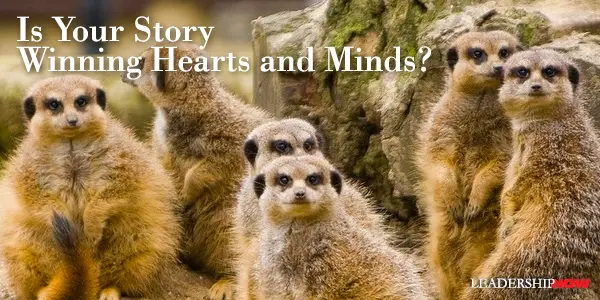
LEADERSHIP is part of a story. Leaders answer the why; they tell the story. Leadership is paradoxical because while leaders must manage the realities, they lead in the ideal. In The Visionary’s Handbook, Watts Wacker and Jim Taylor advise leaders to have the right story—a simple, consistent story that connects the past, present and future. But it needs something more: It should have some melodrama; some action; climax and resolution; a plot that turns toward the good at the end on the strength of a key virtue; a beginning, middle, and end—all the things that were taught in Literature 101 because in the last analysis a great story must be just that: a great story. Negative capability is an interesting concept. It was coined by John Keats in a letter to his brothers (George and Tom), dated December 21, 1817. He wrote: I had not a dispute but a disquisition, with Dilke on various subjects; several things dovetailed in my mind, and at once it struck me what quality went to form a Man of Achievement, especially in Literature, and which Shakespeare possessed so enormously - I mean Negative Capability, that is, when a man is capable of being in uncertainties, mysteries, doubts, without any irritable reaching after fact and reason-Coleridge, for instance, would let go by a fine isolated verisimilitude caught from the Penetralium of mystery, from being incapable of remaining content with half-knowledge. Keats thought, that one of the qualities of great people is their ability to sublimate their own individual assumptions and persona—that is, to make themselves a negative—and thereby contemplate the world without the desire to try and reconcile contradictory aspects or fit it into closed and rational systems. This requires being a good listener and the ability to say, “I don’t know.” 
Posted by Michael McKinney at 03:13 PM
12.07.09

Got Wingmen? Never Fly Solo
AIR FORCE fighter pilot Rob “Waldo” Waldman learned how to overcome fear, anxiety, and self-doubt to fly combat missions that pushed him to his limits by disciplined training and the help of his wingmen. Wingmen are people with different backgrounds, skills, and experiences unified under one agreement—to never think or act alone. A wingman watches your back. In Never Fly Solo, Waldo threads real-world experiences to encourage the development of a check-six culture. Check-six refers to the six o’clock position where the jet is most vulnerable—the pilot’s blind spot. Waldo says, “There is a limit to how much you can learn on your own. A good wingman will give you mission-critical feedback, catch your errors, ask questions, and propose challenging scenarios to push you to grow in your skills and mental discipline.” Encouraging others to look out for our blind spots requires a great deal of mutual trust. “These trusted partners, male or female, are your wingmen.” Of course, this means first, not being afraid to acknowledge that you need help and then being able to ask for it. This is all the more difficult if you haven’t built trust in yourself and invested the time to build trusting relationships with others. You’ve got to “walk the flight line.” Get out and build relationships with those people you work with—treating each other as people first and coworkers second. “It’s the relationships we build and the people whom we trust that give us the courage to take risks and make ourselves better.” By being willing to say, “I don’t know,” or “I messed up,” we create a transparency that will attract others to us and “create the type of environment where people won’t be afraid to make mistakes. They will also be more likely to check your six as well.”Additionally, we have to keep our “radar sweeping for a wingman, coworker, or peer who may be experiencing a challenging time in her life. Don’t let her get isolated.” Be supportive and find her some help if necessary.” It is the worker that keeps to themselves—trying to fly solo—that check out, become unmotivated, complacent and careless. “Never feeling invested in the company’s mission, they do the minimum, and everyone suffers.” In today’s environment, communication, feedback, and mutual support are critical Waldo says because:
“An effective check-six environment frees up communication and removes barriers to growth so that all members of the team feel empowered to speak up and ask questions.” It also builds team confidence. We all need wingmen and the best way to find a wingman is to be one! 
Posted by Michael McKinney at 07:29 AM
12.02.09

Managers Can (and Should) Be Leaders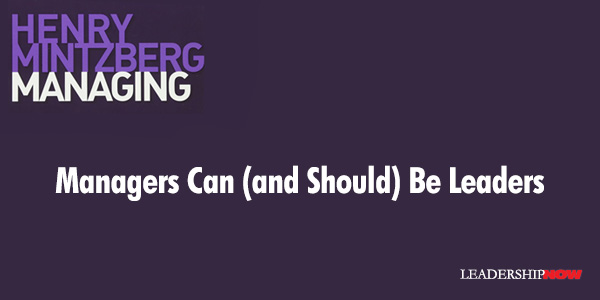
IT HAS BECOME commonplace to regard managers as inferior to leaders. Leaders are out front getting things done and managers are … what are they doing? This is, in part, due to our proclivity to label people as one or the other. Henry Mintzberg is the antidote to that kind of unproductive thinking. He writes in a book simply titled Managing: “we should be seeing managers as leaders and leadership as management practiced well.” While I have maintained that there is value in separating the functions of managers and leaders for the better understanding of both, in practice, they shouldn’t be two different people. Mintzberg believes that managing is a practice that is learned on the job through apprenticeship, mentorship, and direct experience. He has good cause to assert that we should be more concerned about “macroleading;” people that manage by remote control; too far above it all. “We are now overlead and undermanaged, he writes.” By obsessing over the glories of leadership, we lose our grasp on the realities of management. And our leadership is all the worse for it. “The more we obsess about leadership, the less we seem to get.” Managing is a valuable read. Mintzberg always makes you stop and think. He’s at his best when he’s leveling the playing field. As we’ve stressed on this blog before, leadership isn’t evolving. Leadership (and management) are a fundamental human activity. How they are practiced may change depending on the context, but their essence remains unchanged. Much of what we have to learn and relearn are fundamental principles regarding how people get along and work together. Managers deal with different issues as time moves forward, but not with different managing. The job does not change. We buy new gasoline all the time and new shirts from time to time; that does not mean that car engines and buttons have been changing. Despite the great fuss we make about change, the fact is that the basic aspects of human behavior—and what could be more basic than managing and leading?—remain rather stable.Mintzberg has distilled management thought into a general model of managing—what do managers do? They operate on three plains of activity, from the conceptual to the concrete: They act through information. They work through people. They manage action directly. And they need to operate on all three planes. “Too much leading can result in a job free of content…and detached from its internal roots.” A blending of all three planes into a dynamic balance is required and is best learned on the job. “No simulation I have ever seen in a classroom … comes remotely close to replicating the job itself,” says Mintzberg. He playfully addresses the conundrums of managing like: How to keep informed when managing by its own nature removes the manager from the very things being managed? How to delegate when they are better informed than the people to whom they have to delegate? How to maintain a sufficient level of confidence without crossing over into arrogance? How to bring order to the work of others when the work of managing is itself disorderly? And how do you do all these things at once? Managers are flawed. “If you want to uncover someone’s flaws, marry them or else work for them. Their flaws will quickly become apparent. So will something else: that you can usually live with these flaws. Managers and marriages do succeed. The world, as a consequence, continues to unfold in its inimitably imperfect way.” [He adds in the notes: “Not always. Politicians seem to become particularly adept at hiding flaws during elections until they become fatal in office.”] We are successful to the extent that our weaknesses are not fatal relative to the situation we are in. Commitment is the key; commitment “to the job, the people, and the purpose, to be sure, but also to the organization, and beyond that, in a responsible way, to related communities in society.” He concludes, “To be a successful manager, let alone—dare I say—a great leader, maybe you don’t have to be wonderful so much as more or less emotionally healthy and clearheaded.” No institution can possibly survive if it needs geniuses or supermen to manage it. It must be organized in such a way as to be able to get along under a leadership composed of average human beings.”That’s good news!  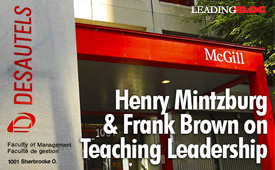 
Posted by Michael McKinney at 01:43 PM
12.01.09

First Look: Leadership Books for December 2009Here's a look at some of the best leadership books to be released in December.




For bulk orders call 1-800-423-8273 NEW EDITIONS: Ira Chaleff's classic, The Courageous Follower is now available in a third edition. It has been updated and includes a new chapter, “The Courage to Speak to the Hierarchy.” The Secret: What Great Leaders Know—And Do by Ken Blanchard and Mark Miller has been released in a new revised and updated second edition. The popular Leadership and Self-Deception has been revised throughout to make the story more readable and compelling and is available next month.
Posted by Michael McKinney at 12:00 AM
|
BUILD YOUR KNOWLEDGE


How to Do Your Start-Up Right STRAIGHT TALK FOR START-UPS 
Grow Your Leadership Skills NEW AND UPCOMING LEADERSHIP BOOKS 
Leadership Minute BITE-SIZE CONCEPTS YOU CAN CHEW ON 
Classic Leadership Books BOOKS TO READ BEFORE YOU LEAD |
|